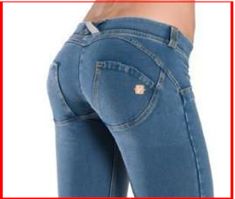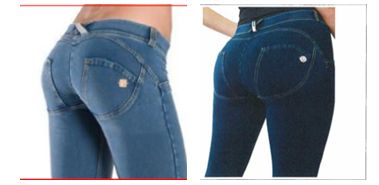A decision of the English High Court recently released shows how protection can be obtained for fashion goods. However, the fact remains that in Canada there are difficulties associated with protecting fashion goods.
Facts
"Body-enhancing" jeans are part of an expanding area of fashion known as shapewear. They can give the appearance of slimmer hips while lifting and separating the buttocks. While body-enhancing undergarments have been popular for centuries, the emergence of shapewear as outer-garments is recent. The plaintiff's jeans were introduced in 2012. The plaintiff says this was a dramatic departure from what was previously available on the market, attracting significant consumer attention and commercial success.
The defendants copied the plaintiff's jeans and marketed their copies under the trademark HUGZ. The plaintiff immediately reacted and as a result a settlement agreement was concluded. Undaunted the defendant then launched a second version of its HUGZ jeans. The plaintiff brought an action for breach of the settlement agreement, patent infringement, infringement of several unregistered design rights and passing off.
Eventually the defendant defaulted in its defence just before the trial was scheduled to begin. Counsel for the plaintiff requested that a reasoned judgement be issued since it was said this would assist the plaintiff in enforcing its patent. The judge agreed.
Patent
The principal of the plaintiff said he had the idea of creating a new pair of women's trousers designed to enhance the body of the wearer. He assembled a team to "help bring my design to life" – including his daughter, in-house designers, and a design agency with experience in the sportswear and dancewear fields. Various iterations of the product were developed before the design was completed. It was like nothing that he had seen and was different but beautiful. The product achieved his vision of creating a unique and beautiful rounded shape that was also comfortable to wear. The individuals involved in developing the design were employees of the plaintiff or assigned all intellectual property rights to the plaintiff.
The plaintiff obtained a patent relating to its product. This is relatively unusual in fashion goods industry since it is expensive to obtain a patent and the potential commercial success of the product is unknown. The plaintiff's product has been successful and the product is sold in over forty countries.
The patent is entitled "Pants, in particular for shaping the female buttocks and hips". The judge found the patent to be valid and infringed by both the initial version and the second version of the HUGZ jeans.
Passing Off
To succeed with its claim, the plaintiff must prove goodwill, a misrepresentation by the defendants, and damage by reason of the erroneous belief engendered by the defendant's misrepresentation.
The plaintiff asserted goodwill in elements making up its jeans. The judge said this was best illustrated by an image of the rear of the jeans shown below (the Get Up):

Misrepresentation and Damages
The plaintiff's expert in her report said that the marketing for both the plaintiff's jeans and the defendants' jeans focused on the back of the jeans. This was not unusual as the back of the jeans is a common focus for branding elements. What was unusual was that the defendants adopted the same branding elements as the plaintiff, which were not common features, and she thought they adopted the same features to associate themselves with the plaintiff.
The plaintiff's jeans are shown below on the left, the First HUGZ Jeans are shown on the right.
It was clear to the expert that the defendants wanted consumers to believe either (a) that the two brands are connected or (b) that a consumer, even if they know that the Defendants are unconnected to the plaintiff when buying the product, wanted other consumers to believe that the defendants' product was associated with the plaintiff and its product.

The plaintiff argued based on this evidence that confusion was occurring both at the time of sale and post sale. The judge accepted this and said that post-sale confusion has been considered in trademark infringement cases, and there was no reason not to apply the same approach. The owner of goodwill in a product is entitled to have this goodwill protected throughout the life of the product, not just at the point of sale. The HUGZ Get-Up will continue to make misrepresentations whenever the HUGZ jeans are worn. This misrepresentation damages the plaintiff.
Unregistered Design
in England and the EU the design of a product is protected for a term of three years with no requirement for registration. Here the plaintiff was substantially successful with its claim relating to its unregistered design for the jeans.
Because of the above the judge concluded that the defendants were liable to the plaintiff for infringement of the patent and a substantial portion of the design, passing off and breaching the settlement agreement.
Canadian Position
In Canada the plaintiff would have similar claims for patent infringement if it owned a Canadian patent registration, passing off and breach of the settlement agreement.
Unfortunately, there is no equivalent of an unregistered design right. To obtain similar protection an industrial design registration must be obtained. The registration for such a right must be sought within one year of the publication of the design in Canada or elsewhere in the world.
It can be difficult to assert a claim for passing off relating to the shape of a product when the goods are sold in conjunction with the trademark.
A patent can only be obtained where the development is new, inventive and useful. In addition, the expense of applying can be fairly significant. For these reasons the prospect of obtaining protection is relatively limited.
While protection under the Industrial Design Act is available many people fail to consider it as a viable method of obtaining protection. Also as noted above applications need to be filed early in the process to avoid the one-year bar. However, it is possible to concurrently file in multiple countries.
Originally Published by GSNH, December 2020
The content of this article is intended to provide a general guide to the subject matter. Specialist advice should be sought about your specific circumstances.

